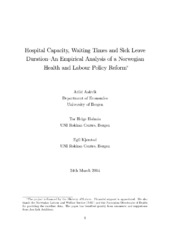| dc.contributor.author | Aakvik, Arild | |
| dc.contributor.author | Holmås, Tor Helge | |
| dc.contributor.author | Kjerstad, Egil | |
| dc.date.accessioned | 2018-01-05T11:43:02Z | |
| dc.date.available | 2018-01-05T11:43:02Z | |
| dc.date.issued | 2015-03 | |
| dc.Published | Aakvik A, Holmås TH, Kjerstad E. Prioritization and the elusive effect on welfare - A Norwegian health care reform revisited. Social Science and Medicine. 2015;128:290-300 | eng |
| dc.identifier.issn | 1873-5347 | |
| dc.identifier.issn | 0277-9536 | |
| dc.identifier.uri | https://hdl.handle.net/1956/17148 | |
| dc.description.abstract | The Faster Return to Work (FRW) scheme that Norwegian authorities implemented in 2007 is an example of a policy that builds on the human capital approach. The main idea behind the scheme is that long waiting times for hospital treatment lead to unnecessarily long periods of absence from work. To achieve a reduction in average sickness absence duration, the allocation of FRW funds and new treatment capacity is exclusively aimed at people on sick leave. Many countries have allocated funds to reduce waiting times for hospital treatment and research shows that more resources allocated to the hospital sector can reduce waiting times. Our results support this as the FRW scheme significantly reduces waiting times. However, on average the reduction in waiting times is not transformed into an equally large reduction in the sickness absence period. We find significant difference in the effects of FRW on length of sick leave between surgical and non-surgical patients though. The duration of sick leave for FRW patients undergoing surgical treatment is approximately 14 days shorter than for surgical patients on the regular waiting list. We find no significant effect of the scheme on length of sick leave for non-surgical patients. In sum, our welfare analysis indicates that prioritization of the kind that the FRW scheme represents is not as straightforward as one would expect. The FRW scheme costs more than it contributes in reduced productivity loss. We base our analyses on several different econometric methods using register data on approximately 13 500 individuals over the period 2007–2008. | en_US |
| dc.language.iso | eng | eng |
| dc.publisher | Elsevier | eng |
| dc.subject | Norway | eng |
| dc.subject | Waiting times | eng |
| dc.subject | Prioritization | eng |
| dc.subject | Sickness absence | eng |
| dc.title | Prioritization and the elusive effect on welfare - A Norwegian health care reform revisited | eng |
| dc.type | Journal article | en_US |
| dc.date.updated | 2017-10-13T09:06:24Z | |
| dc.description.version | submittedVersion | |
| dc.rights.holder | Copyright the authors | en_US |
| dc.identifier.doi | https://doi.org/10.1016/j.socscimed.2015.01.044 | |
| dc.identifier.cristin | 1240306 | |
| dc.source.journal | Social Science and Medicine | |
| dc.relation.project | Norges forskningsråd: 199832 | |
| dc.subject.nsi | VDP::Samfunnsvitenskap: 200::Økonomi: 210::Samfunnsøkonomi: 212 | |
| dc.subject.nsi | VDP::Social sciences: 200::Economics: 210::Economics: 212 | |
